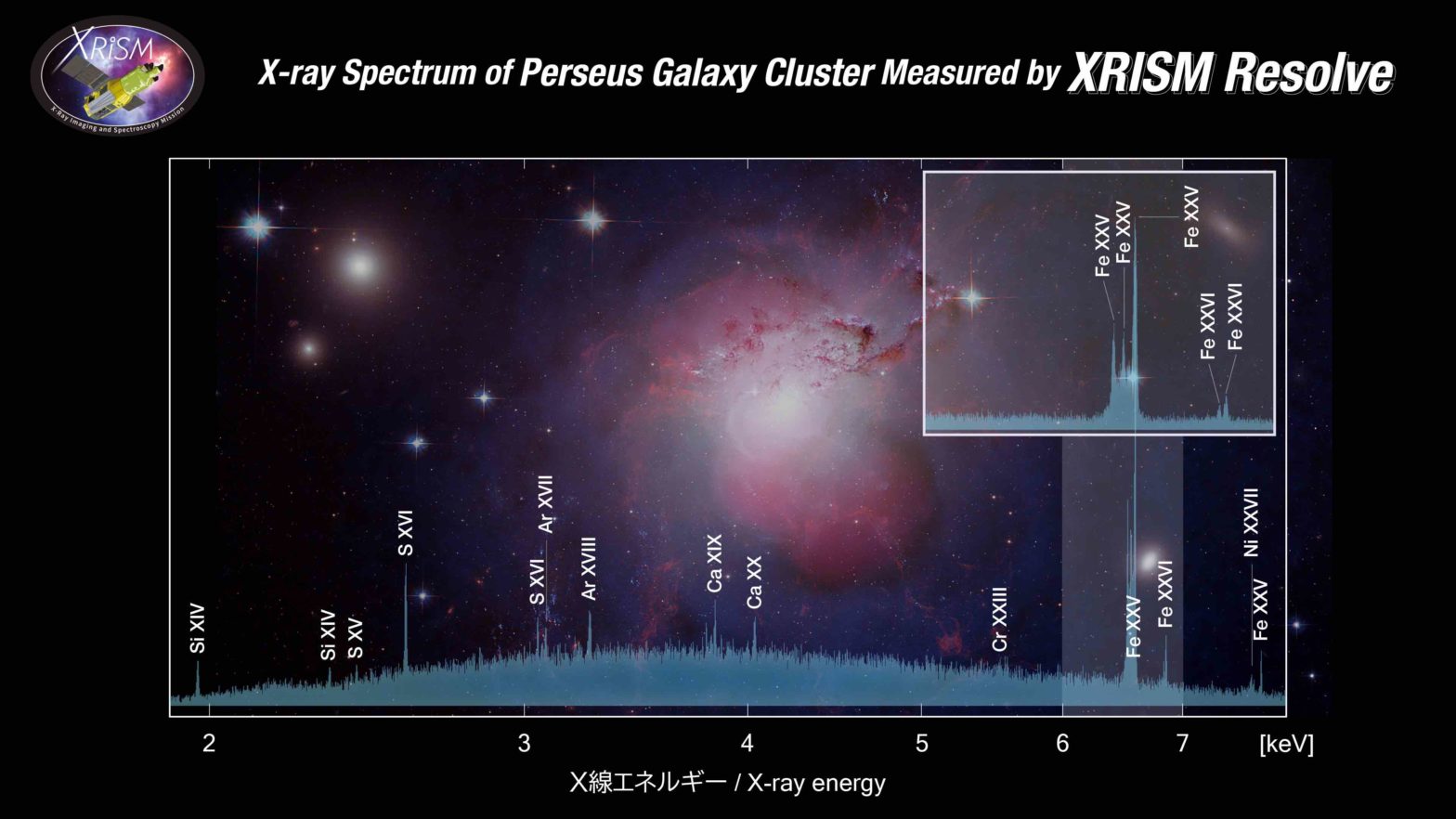The Japan Aerospace Exploration Agency (JAXA) has released the first glimpses of X-ray observation data of the satellite’s soft X-ray imager (Xtend *1) and soft X-ray spectrometer (Resolve *1) on board the X-ray Imaging and Spectroscopy Mission (XRISM).
Following the bus instrument’s preliminary functional verification, Xtend and Resolve underwent meticulous checks and adjustments starting October 7, 2023. The first light observations for each instrument were subsequently conducted.

In Figure 1, the image showcases a galaxy cluster, Abell 2319, where the purple hues signify the distribution of high-temperature plasma emitting X-rays. Abell 2319 is a system in which two galaxy clusters are colliding. Xtend’s unique capability to capture the entire cluster in a single observation, revealing the intricate distribution of hot gas associated with each cluster, promises a significant advancement in our comprehension of galaxy clusters and the Universe’s large-scale structure evolution. (Link to high-res images of Figure 1)

In Figure 2, we encounter an X-ray spectrum (*2) of the supernova remnant N132D in the Large Magellanic Cloud. The white spectrum from Resolve, exhibiting emission lines (*3) from various ions in the 1,800 -10,000 eV bandwidth, surpasses its predecessor, Suzaku, in separating previously indistinguishable lines. By dividing emission lines, the type and abundance of elements, the temperature and kinetic velocity of the high-temperature gas can be derived much more accurately than before. Resolve’s ultra-high resolution spectroscopic observations and impressive energy spectral accuracy below 5 eV, confirmed in orbit, set the stage for new insights into the Universe’s elemental formation and evolution, which are the basis of stars, planets, and life. Although Resolve’s spectra are still limited to 1,800 eV and above because the Dewar aperture door (*4) to protect the sensitive detector has yet to be opened, this band’s highest emission line sensitivity is evident. (Link to high-res images of Figure 2)
The spacecraft maintains optimal conditions, with ongoing commissioning operations aiming for a seamless transition to the calibration and performance verification phases. The bus equipment’s functional verification and the enhanced safety features mark significant milestones. Xtend, with its cooled X-ray CCDs (*5) and Resolve, boasting a cryogenically cooled X-ray microcalorimeter (*6) achieving spectral resolution below 5 eV, are positioned for groundbreaking observations, even with the dewar aperture door closed. Plans include advancing to the calibration and performance verification phases in February 2024 and initiating full-scale observations for initial calibration verification concurrently with efforts to open the dewar aperture door. Scientists and engineers alike are thrilled by these successful first-light observations, foreseeing many groundbreaking discoveries.
*1 Xtend: X-ray imaging spectrometer using an X-ray telescope and X-ray CCD; Resolve: X-ray spectrometer using an X-ray telescope and microcalorimeter. Both perform imaging and spectroscopy, but Xtend and Resolve specialize in imaging and spectroscopy.
*2 X-ray spectrum: A spectrum that indicates how much of each energy band of X-rays is emitted.
*3 Emission Line: X-ray emission with the specific energy of each element. Characteristic X-rays.
*4 Dewar aperture door: Protective window attached to the X-ray incidence area of the Resolve detector. It protects the sensor from the atmosphere on the ground and prevents outgassing from inside the satellite after launch from adhering to the optical blocking filters inside the Dewar detector. The window section has a 250-micron-thick beryllium film, so functional performance can be checked using X-rays even when the section is closed. The beryllium window shields X-rays below about 2,000 eV, and when the mounting mechanism opens the window, X-rays from 300 eV can be observed.
*5 X-ray CCD: Like a visible light telescope, an X-ray CCD can capture and take images of X-rays from celestial objects. The principle is the same as that of commercially available digital cameras. However, the X-ray CCDs are designed with increased sensitivity to X-rays. The X-rays entering the semiconductor are converted into electrons, which are then converted into electrical signals to produce an image.
*6 X-ray microcalorimeter is a device that measures the magnitude of energy through the temperature of an X-ray beam rising very slightly when it hits the element. The microcalorimeter makes it possible to measure the X-ray source’s temperature, composition, and velocity being observed with great precision.


